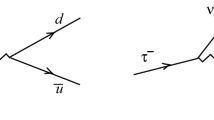Abstract
Tau-lepton semileptonic decays are described in the Nambu–Jona-Lasinio framework, and the validity of this description is discussed. Tau decays with a neutrino, a vector meson, and a pseudoscalar meson in the final state are considered. The extended version of the NJL model is employed, which makes possible the consideration of the contributions of both the ground and first radially excited meson states.






Similar content being viewed by others
REFERENCES
Y. Nambu and G. Jona-Lasinio, “Dynamical model of elementary particles based on an analogy with superconductivity. I.,” Phys. Rev. 122, 345 (1961).
Y. Nambu and G. Jona-Lasinio, “Dynamical model of elementary particles based on an analogy with superconductivity. II.,” Phys. Rev. 124, 246 (1961).
B. A. Arbuzov, A. N. Tavkhelidze, and R. N. Faustov, “On the fermion mass in a \({{\gamma }^{5}}\)-invariant quantum field theory,” Dokl. Akad. Nauk SSSR 139, 345–347 (1961) [in Russian].
T. Eguchi, “A new approach to collective phenomena in superconductivity models,” Phys. Rev. D 14, 2755 (1976).
M. K. Volkov and D. Ebert, “Four-quark interactions as a common source of the vector meson dominance and sigma model,” Yad. Fiz. 36, 1265–1277 (1982) [in Russian].
D. Ebert and M. K. Volkov, “Composite meson model with vector dominance based on U(2) invariant four quark interactions,” Z. Phys. C 16, 205 (1983).
M. K. Volkov, “Meson Lagrangians in a superconductor quark model,” Ann. Phys. (N. Y.) 157, 282 (1984).
M. K. Volkov, “Low-energy meson physics in the quark model of superconductivity type,” Sov. J. Part. Nucl. 17, 186 (1986) [in Russian].
D. Ebert and H. Reinhardt, “Effective chiral hadron Lagrangian with anomalies and Skyrme terms from quark flavor dynamics,” Nucl. Phys. B 271, 188–226 (1986).
M. K. Volkov and A. E. Radzhabov, “The Nambu–Jona-Lasinio model and its development,” Phys. Usp. 49, 551 (2006).
M. K. Volkov and C. Weiss, “A chiral Lagrangian for excited pions,” Phys. Rev. D 56, 221 (1997).
M. K. Volkov, “The pseudoscalar and vector excited mesons in the U(3) × U(3) chiral model,” Phys. Atom. Nucl. 60, 1920 (1997).
M. K. Volkov, D. Ebert, and M. Nagy, “Excited pions, rho and omega mesons and their decays in a chiral SU(2) × SU(2) Lagrangian,” Int. J. Mod. Phys. A 13, 5443 (1998).
M. K. Volkov and A. B. Arbuzov, “Meson production processes in electron-positron collisions and tau-lepton decays within the extended Nambu–Jona-Lasinio model,” Phys. Usp. 60, 643–666 (2017).
M. Suzuki, “Strange axial-vector mesons,” Phys. Rev. D 47, 1252–1255 (1993).
M. Tanabashi et al. (Particle Data Group), “Review of particle physics,” Phys. Rev. D 98, 030001 (2018).
M. K. Volkov and A. A. Pivovarov, “The \(\tau \to {{\bar {K}}^{0}}{\text{*}}(892){{\pi }^{ - }}{{\nu }_{\tau }}\) decay taking into account the splitting of an intermediate ground-state axial-vector meson K \(_{{1A}}\) into two physical states K \(_{1}\)(1270) and K \(_{1}\)(1400),” JETP Lett. 110, 237–241 (2019).
M. K. Volkov, A. A. Pivovarov, and K. Nurlan, “The decays \(\tau \to [\omega (782),\phi (1020)]{{K}^{ - }}{{\nu }_{\tau }}\) in the extended NJL model,” Eur. Phys. J. A 55, 165 (2019).
K. Inami et al. (Belle Collab.), “First observation of the decay \({{\tau }^{ - }} \to \phi {{K}^{ - }}{{\nu }_{\tau }}\),” Phys. Lett. B 643, 5–10 (2006).
B. Aubert et al. (BaBar Collab.), “Exclusive branching fraction measurements of semileptonic tau decays into three charged hadrons, \({{\tau }^{ - }} \to \phi {{\pi }^{ - }}{{\nu }_{\tau }}\) and \({{\tau }^{ - }} \to \phi {{K}^{ - }}{{\nu }_{\tau }}\),” Phys. Rev. Lett. 100, 011801 (2008).
K. E. Arms et al. (CLEO Collab.), “Study of tau decays to four-hadron final states with kaons,” Phys. Rev. Lett. 94, 241802 (2005).
A. M. Volkov, K. Nurlan, and A. A. Pivovarov, “The decays \(\tau \to (K,K(1460)){{\nu }_{\tau }}\) and the value of the weak decay constants \({{F}_{K}}\) and \({{F}_{{K'}}}\) in the extended NJL model,” Int. J. Mod. Phys. A 34, 1950137 (2019).
M. K. Volkov and A. A. Pivovarov, “Effects of K–K1 transitions on kaon-field renormalization in the NJL model framework,” Phys. Part. Nucl. Lett. 16, 565 (2019).
Author information
Authors and Affiliations
Corresponding authors
Additional information
Translated by A. Asratyan
Rights and permissions
About this article
Cite this article
Volkov, M.K., Arbuzov, A.B., Nurlan, K. et al. \(\tau \to K{\text{*}}\pi \nu \) and \(\tau \to [\phi ,\omega ]K\nu \) Decays in the Extended Nambu–Jona-Lasinio Model. Phys. Part. Nuclei 51, 720–724 (2020). https://doi.org/10.1134/S1063779620040759
Received:
Revised:
Accepted:
Published:
Issue Date:
DOI: https://doi.org/10.1134/S1063779620040759




